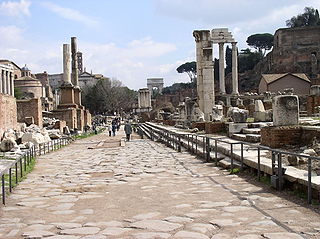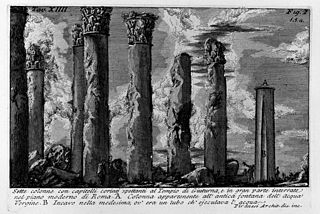
The Palus Caprae (or Capreae; [1] meaning "Goat Marsh" or "the Goat's pool" [2] ) was a site within the Campus Martius in Ancient Rome. In Roman mythology, the Palus Caprae was the place where Romulus underwent ascension into godhood.

The Palus Caprae (or Capreae; [1] meaning "Goat Marsh" or "the Goat's pool" [2] ) was a site within the Campus Martius in Ancient Rome. In Roman mythology, the Palus Caprae was the place where Romulus underwent ascension into godhood.
The marsh was fed by a stream called Petronia Amnis, [3] [4] but by the Augustan period it had disappeared or been drained. [5] The Palus Caprae was in the small basin where the Pantheon was later built, [6] west of the Altar of Mars supposed to have been established by Numa Pompilius, Romulus's successor. [7] Ludwig Preller thought it might be the same site as the Aedicula Capraria in Regio VI (Via Lata), as listed by the Regiones, [8] and Filippo Coarelli conjectured that the mythic significance of the Palus Caprae was the reason for siting the Pantheon there. [9]
On the Nones of Quinctilis (July 7), Romulus was reviewing the army on the Campus Martius near the Palus Caprae. Suddenly a storm broke out, accompanied by a solar eclipse, and a deluge consumed the place. When it cleared and the terrified Romans reemerged from their places of refuge, their king was nowhere to be found.
Julius Proculus claimed that Romulus appeared to him in a dream and announced that he was henceforth to be known as the god Quirinus, because the gods had taken him up to live among them. Although Romulus is not said to have died, his tomb was supposed to be located on the Comitium under the Lapis Niger. [10]
The occasion was commemorated ritually by the Nonae Caprotinae.

The Aventine Hill is one of the Seven Hills on which ancient Rome was built. It belongs to Ripa, the twelfth rione, or ward, of Rome. The part of the city that stands on it is sometimes referred to as Reme, or Ream.

The Campus Martius was a publicly owned area of ancient Rome about 2 square kilometres in extent. In the Middle Ages, it was the most populous area of Rome. The IV rione of Rome, Campo Marzio, which covers a smaller section of the original area, bears the same name.

The Ficus Ruminalis was a wild fig tree that had religious and mythological significance in ancient Rome. It stood near the small cave known as the Lupercal at the foot of the Palatine Hill and was the spot where according to tradition the floating makeshift cradle of Romulus and Remus landed on the banks of the Tiber. There they were nurtured by the she-wolf and discovered by Faustulus. The tree was sacred to Rumina, one of the birth and childhood deities, who protected breastfeeding in humans and animals. St. Augustine mentions a Jupiter Ruminus.

The Via Sacra was the main street of ancient Rome, leading from the top of the Capitoline Hill, through some of the most important religious sites of the Forum, to the Colosseum.

The Saepta Julia was a building in the Campus Martius of Rome, where citizens gathered to cast votes. The building was conceived by Julius Caesar and dedicated by Marcus Vipsanius Agrippa in 26 BCE. The building replaced an older structure, called the Ovile, built as a place for the comitia tributa to gather to cast votes. The Saepta Julia can be seen on the Forma Urbis Romae, a map of the city of Rome as it existed in the early 3rd century CE. Part of the original wall of the Saepta Julia can still be seen right next to the Pantheon.

The Shrine of Venus Cloacina — the "Shrine of Venus of the Sewer" — was a small sanctuary on the Roman Forum, honoring the divinity of the Cloaca Maxima, the spirit of the "Great Drain" or Sewer of Rome. Cloacina, the Etruscan goddess associated with the entrance to the sewer system, was later identified with the Roman goddess Venus for unknown reasons, according to Pliny the Elder.

In ancient Roman religion and myth, Mars was the god of war and also an agricultural guardian, a combination characteristic of early Rome. He was the son of Jupiter and Juno, and he was the most prominent of the military gods in the religion of the Roman army. Most of his festivals were held in March, the month named for him, and in October, which began the season for military campaigning and ended the season for farming.

The Shrine of Vulcan, or Vulcanal, or Volcanal, was an 8th-century BC sacred precinct on the future site of the Roman Forum in Rome, modern Italy. Dedicated to Vulcan, the Roman god of fire, it was traditionally considered to commemorate the spot where the legendary figures Romulus and Tatius concluded the peace treaty between the tribes known as the Latins — on the Palatine Hill — and the Sabines — on the Quirinal and Esquiline. This famous merger of the hill-villages was said to be the foundation of the Roman state.

The Domus Augustana is the modern name given to the central residential part of the vast Roman Palace of Domitian on the Palatine Hill. In antiquity the name may have applied to the whole of the palace.

The Ciconiae Nixae was a landmark, or more likely two separate landmarks, in the Campus Martius of ancient Rome. In A New Topographical Dictionary of Ancient Rome, Lawrence Richardson regards a single site called Ciconiae Nixae as "hypothetical," noting that the subject "has long exercised topographers." The two words are juxtaposed in the regionary lists and located in Region IX near the Tiber River. The 4th-century calendar of Filocalus notes vaguely that the October Horse happened ad nixas, "at the Nixae," suggesting that the regionaries' Ciconiae ("Storks") ought to be taken as a separate entry. Inscriptional evidence also indicates that the Ciconiae was a separate landmark, and that it had to do with wine shipments brought in on the Tiber.

The Porta Fontinalis was a gate in the Servian Wall in ancient Rome. It was located on the northern slope of the Capitoline Hill, probably the northeast shoulder over the Clivus Argentarius. The Via Salaria exited through it, as did the Via Flaminia originally, providing a direct link with Picene and Gallic territory. After the Aurelian Walls were constructed toward the end of the 3rd century AD, the section of the Via Flaminia that ran between the Porta Fontinalis and the new Porta Flaminia was called the Via Lata ("Broadway").
The Lautumiae were tufa quarries that became a topographical marker in ancient Rome. They were located on the northeast slope of the Capitoline Hill, forming one side of the Graecostasis, where foreign embassies gathered prior to appearing before the Roman senate.

Fortuna Huiusce Diei was an aspect of the goddess Fortuna, known primarily for her temple in the Area Sacra di Largo Argentina at Rome. Cicero lists her among the deities who should be cultivated in his ideal state, because "she empowers each day". She thus embodies an important aspect of time as it figures in Roman religion: every day of the year had a distinct and potent nature, which the public priests were responsible for knowing and aligning the community with by means of the religious calendar.
The Gaianum was an area in the Transtiberim in ancient Rome. It is located in Regio XIV, about 300m northwest of the Mausoleum of Hadrian, south of the Naumachia Vaticana built by Trajan, and east of the Via Triumphalis. The historian Cassius Dio says that Caligula, also commonly known in ancient sources as Gaius, used the Gaianum for chariot exercises. A number of victory statues have been found in the area, but seem to have been installed originally at the Circus of Gaius and Nero. The Gaianum was probably only a track, not a circus building as such.

The Temple of Matidia was a Roman temple on the Campus Martius in ancient Rome dedicated to Salonia Matidia, who was deified after her death in 119 by her son-in-law Hadrian. He began construction immediately after her deification, choosing a site near the Pantheon and the Saepta Julia, both of which he restored or rebuilt. A lead water pipe inscribed 'templo matidiae' was found near Sant'Ignazio, which may indicate the temple's location. After Hadrian died and was deified, his own temple was built next to that of Matidia.
The Temple of Mars was a temple built on the campus Martius in Rome in the 2nd century BC, near the Circus Flaminius, dedicated to Mars.
The Navalia was a military port of Ancient Rome which may also have included a naval dockyard. It is thought to have been sited on the left bank of the river Tiber to the south of the Campus Martius and is sometimes called the 'Navalia superiora' to distinguish it from another military port further down the Tiber near the Forum Boarium. The structures, probably gable roofed shipsheds of the period, were also mentioned as being used to hold hostages and circus animals, perhaps during the later period where silting meant navigation on the upper Tiber had become difficult.
The Temple of Vulcan was a temple dedicated to Vulcan on the Campus Martius in Rome, probably near the Circus Flaminius. Legend holds that it was built by Romulus. It was struck by lightning in both 214 BC and 197 BC.

The Basilica of Neptune was a basilica built in Rome by Marcus Vipsanius Agrippa in honour of Neptune and in celebration of his naval victories at Mylae, Naulochus and Actium. Near the site of the Pantheon, its remains were restored under Hadrian for an unknown use. The Temple of Hadrian was once misidentified with the basilica.
The Arch of Pietas was an ancient Roman triumphal arch to the north of the Pantheon on the Campus Martius in Rome.